
NewsInformation Center
Determining the Light Transmission of Fabrics through Different Measurement Meth
2019/03/22
The study aims to present a relationship between air permeability of woven fabrics and their light transmission properties. Polyester / cotton (48:52) blended woven fabrics were utilized in the study. Air permeability is measured using the standard test method already established while the light transmission through the fabric is measured by means of two different methods. One method is based on measurement of light transmitted from a back lit fabric by means of a light sensor. The second method is based on image processing techniques which require a digital back lit image of fabric and an algorithm is applied to measure the amount of light transmitted through it. Results from both methods are compared and correlated with the air permeability and porosity of woven fabrics. Analysis shows that the results from former method have a stronger and more significant relationship with air permeability of woven fabrics comparatively.
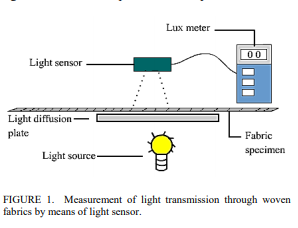
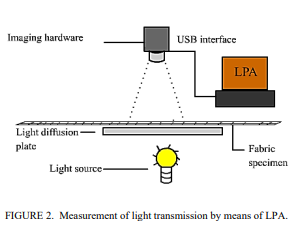
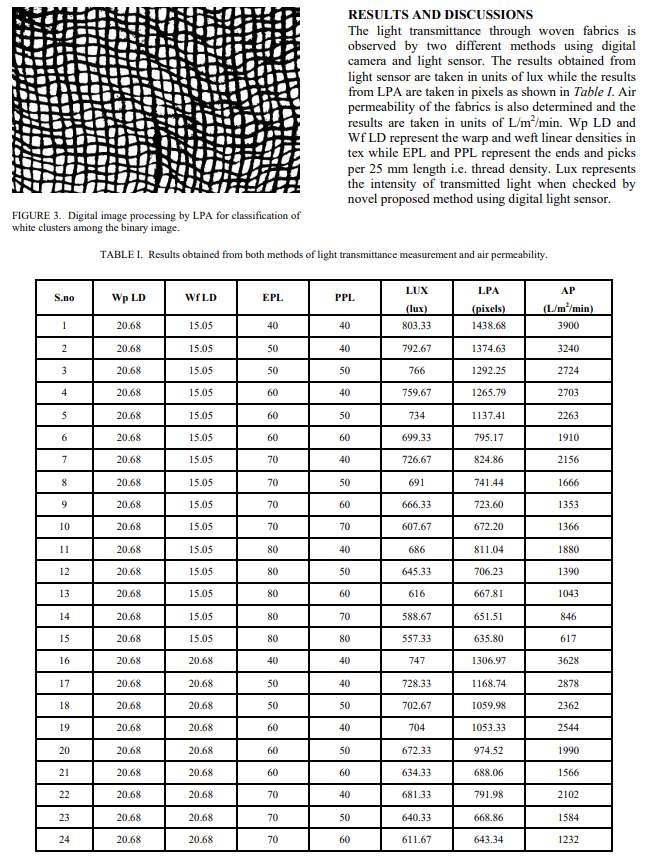
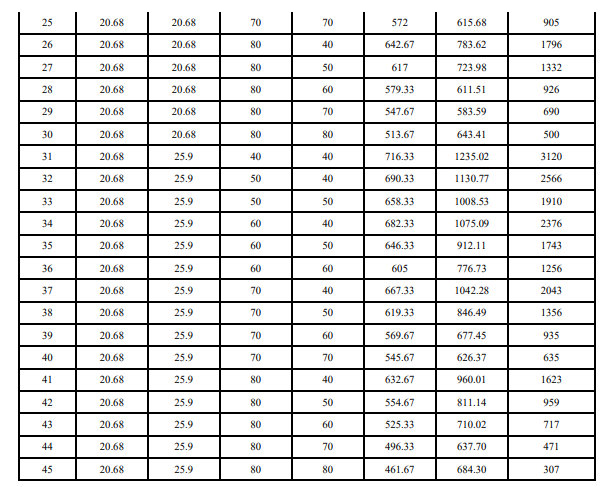
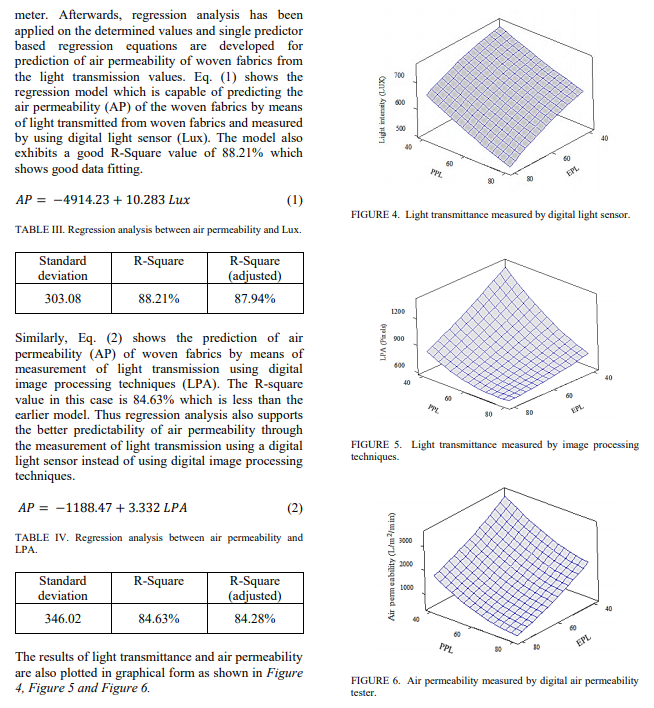
INTRODUCTION
Woven fabrics are most commonly used fabric type in our daily life. Its application ranges from aesthetical to technical usage [1]. Mostly they are utilized for clothing and upholstery in spite of their rapidly and equally increasing consumption in technical textiles. The properties of woven fabric are decided purely upon its end use. The construction parameters of a woven fabric used for clothing are entirely different from a fabric that is intended to be used for a technical application. Some of the wellknown properties of woven fabrics involve tensile strength, tear strength, flexural rigidity, thermal conductivity, moisture management and air permeability. All these characteristics are well explored in recent decades and relationships are well established. However, light permeability which may be a potential characteristic of woven fabrics is less known yet.
Light permeability of fabrics is not that sort of property which decides the fabric aesthetics or quality but it is the parameter which has strong relationship with UPF (ultra violet protection factor) of the clothing and garments which relates with certain health issues. Overexposure to UV light for long period of time can cause serious health concerns like skin burns, swelling, blisters and etc. Also eye can develop photo keratitis and photo conjunctivitis which are painful injuries. UV light from sun can cause negative impact on the immune system as well. The extent to which a fabric provides resistance to UV light rays is described in terms of UPF [3].UPF can be defined as the units of ultra violet light blocked by the apparel out of totally exposed UV units. Normally a UPF rating of 15-24 is considered as good, 25-40 as very good and 40-50+ as excellent.UV blocking ability of the apparel depends on various factors including type of material used, yarn parameters, fabric construction, applied finishes and color [4-9]. Along with harmful effects on the human health UV radiations also become a cause of tendering of cellulosic material like cotton etc.
The light permeability should be considered while evaluating the performance of certain home textile articles like curtains and etc. It is a desirable property of curtains that they should be able to stop unwanted light as well as sound from the outdoors reducing the light pollution. Like air permeability of the fabrics, light transmission is also dependent on fabric porosity. Haleem et al. showed that air permeability is totally dependent on pores in between the yarns which are decided on basis of thread densities and yarn linear densities [11]. Militky et al. worked out the relationship between air permeability and light transmission of the woven fabrics [12]. Software named LUCIA was developed which measured the light transmission from the fabric samples by means of image analysis. The back lit digital images of the fabrics were placed under a camera and image processing algorithm was developed for measuring the bright regions in the fabric.
In this study, we have focused on accurate measurement of light transmission from the woven fabrics. In this regard, two different methods are introduced which are based on image processing and digital light sensor. Image processing algorithm is fine-tuned as compared to classic one presented by Militky and a novel method based on light sensor is proposed. Results from both techniques are compared and analyzed with each other and finally correlated with air permeability of woven fabrics samples to develop a better model for predicting the air permeability by a simple method of light transmittance.
MATERIALS AND METHODS
Poly cotton blended (52:48) yarns were woven into fabrics with weave design of 3/1 S twill weave on a Sulzer weaving machine (P 7150). Fabrics were developed with controlled variation in yarn linear densities and fabric thread densities. Three different levels of weft yarn linear densities i.e. 15, 20 and 25 tex while five different levels of both warp and weft thread densities i.e. 40, 50, 60, 70, 80 per 25 mm were selected. The yarns of 20 tex were used as warps in all fabric constructions. The desizing of the fabrics was done by enzymatic desizing method.After desizing, all the fabric samples were first preconditioned at a temperature of 47°C and relative humidity of 10 to 25 % for 4 hours in a hot air oven.Afterwards the conditioning of the fabric samples was carried out for 24 hours at standard conditions according to ASTM D 1776 [13]. The fabric areal density and fabric thickness were measured through standard test methods ASTM D 3776 and ASTM D1777 respectively.
The air permeability of all fabric samples was measured according to ASTM D737 test method[16]. Fabrics were tested on SDL air permeability tester. A testing head of 20 cm2 was selected for testing the fabric samples on digital air permeability tester. A constant air pressure of 100 Pascal was maintained for fabric testing on the tester. The results from the instrument were taken in units of L/m2 /min.
To determine the light permeability transmittance through the woven fabrics two different methods were focused. First method was based on determination of light transmission through fabric by means of digital light sensor. The fabric sample was placed on a frosted plate followed by a light source. The light sensor is mounted on the top of the fabric at a distance of about 5 inches from fabric surface as shown in Figure 1. The light sensor is further attached to the digital meter which displays quantified light intensity coming out of fabric surface. The whole experimental setup was concealed and isolated from external environment by means of opaque wooden sheets to avoid influence of external light conditions on experimental setup.

In the second method, light sensor was replaced by digital camera connected to the computer by means of USB interface as shown in Figure 2. A software named LPA (Light permeability analyzer) was developed in MATLAB 2011b based on image processing techniques is interfaced with the imaging hardware. The frames captured by the camera were transferred to the computer and images were then processed by means of LPA software. The software firstly converts the images into binary format and then processes them to find the white clusters in it which indicate the light transmitting through the fabric. The image processed by LPA is shown in Figure 3.

RESULTS AND DISCUSSIONS
The light transmittance through woven fabrics is observed by two different methods using digital camera and light sensor. The results obtained from light sensor are taken in units of lux while the results from LPA are taken in pixels as shown in Table I. Air permeability of the fabrics is also determined and the results are taken in units of L/m2/min. Wp LD and Wf LD represent the warp and weft linear densities in tex while EPL and PPL represent the ends and picks per 25 mm length i.e. thread density. Lux represents the intensity of transmitted light when checked by novel proposed method using digital light sensor.


Similarly LPA is the measurement of white clusters in the digital image of fabric when evaluated by using digital image processing techniques. AP represents the air permeability measured by the digital air permeability tester. After obtaining the results of light transmittance from both methods, correlation analysis is carried out between all three responses and Pearson correlation values are found out. According to the analysis results as shown in Table II, there exists a strong relationship between all three response variables as the values of Pearson correlation are approaching 1 which is representation of existence of strong correlation among the analyzed variables. Similarly the P-Values are less than 0.05 which also supports the above stated logic by rejecting the null hypothesis of no correlation existence.
An interesting point to note in the correlation analysis is relatively stronger correlation of air permeability(AP) with the light transmission measured by novel proposed method (Lux) i.e. 0.939 as compared to the method based on image processing technique (LPA)i.e. 0.920. This logic gives an indication of more accurate prediction of air permeability from light transmission behavior of the fabrics when measured by the novel proposed method of using light intensity meter. Afterwards, regression analysis has been applied on the determined values and single predictor based regression equations are developed for prediction of air permeability of woven fabrics from the light transmission values. Eq. (1) shows the regression model which is capable of predicting the air permeability (AP) of the woven fabrics by means of light transmitted from woven fabrics and measured by using digital light sensor (Lux). The model also exhibits a good R-Square value of 88.21% which shows good data fitting.

The graphs are plotted among three response variables and both types of thread densities individually. This provides a general overview of correlation between these variables. It is obvious from all three plots that thread densities i.e. EPL and PPL are directly correlated with LUX, LPA and AP and increment in them causes significant increment in all three response variables. As all three variables are dependent on thread densities it is possible to predict one of them on basis of other.
CONCLUSION
In this study light transmittance through woven fabrics is evaluated by means of two different measurement methods. One method is based on measuring the transmitted light intensity by utilizing a light sensor based setup while the other captures back lit digital images of the woven fabrics through a digital camera and process them to find the white regions from it and compute light transmission through it. The former method is novel one while the latter is modified form of already reported method of light transmission measurement. The results showed that the former method is superior to latter method as it showed good R-square and Pearson correlation value with air permeability of woven fabrics which is measured by industrially applied method. Apart from statistical analysis, the former method is itself simple in nature as compared to the latter one as it does not use any complex algorithms and is more robust and reproducible in nature. Hence it can be concluded that light transmission is an important fabric characteristic which can provide information about certain structural aspects of the fabric. Utilizing light intensity sensor for this purpose is appropriate mean of measurement. Light permeability can be used as predictor of air permeability of woven fabrics. Also this parameter can be successfully correlated with air permeability of the woven fabrics and can be used for its accurate prediction as well. This forecasting of air permeability by merely transmitting light from the woven fabrics can be helpful for engineers and weavers as it will give good estimation about fabric porosity and create possibility of non-contact /nondestructive measurement of air permeability of the fabrics.
Previous: Significance and Use of fabric thermal transmittance tester
N e x t : How to select the most suitable Tensile Tester



